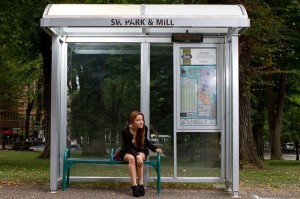Winnipeg’s infrastructure deficit is extreme. It is currently sitting at $7 billion which works out to more than $10,000 for every single Winnipegger or nearly $30,000 per Winnipeg household. This is, in part, a consequence of sprawl.
Winnipeggers will have to pay for this somehow. And the younger you are now, the more likely it is you’re going to be around when the city finally has to collect. Winnipeggers will also have to come up with a long-term strategy for preventing the deficit from growing. Property taxes either have to go way up or we have to find a way to curb sprawl.
 It’s well known that the personal automobile drives sprawl. Facing massive infrastructure deficits, cities across North America are investing in public transit in order to curb the constant pressure to build outward.
It’s well known that the personal automobile drives sprawl. Facing massive infrastructure deficits, cities across North America are investing in public transit in order to curb the constant pressure to build outward.
In order to be effective, transit investment in Winnipeg must be used to tip the balance between cars and buses and make taking a bus more convenient than taking a car. But cars have some significant advantages that have to be overcome.
Transfers and Walking Distance
Good transit policy seeks to reduce the time-consuming element of bus riding. Anyone who’s ever taken a bus knows that transfers and walking to the bus stop are the most time consuming elements of public transit system.
The plan we advocate for, investing in hundreds of new buses, will lead to greater frequency on all routes, including the all-important feeder routes. By preserving the existing system, bus stops will continue to be approximately 300-400 meters apart (like they are on Pembina Highway) and with buses coming more often, those bus stops along feeder routes that are close to people’s houses will become significantly more useful.
More buses will also significantly improve transfer time. Transferring between buses can easily add 10 or more minutes to a trip. When a rider needs to connect to another route, it often makes for a much more stressful trip. If the connecting bus comes every 20 minutes, it really sucks to miss that bus. This is another problem that frequent buses solves. When a bus comes every five minutes, missing the one you intended to catch is not nearly as frustrating. Frequent bus service works as a kind of reliability.
The Southwest Corridor does not solve the walking and transfer problems.
Walking distances are actually made worse. On the existing Rapid Transit line bus stops are 1.2 kilometers apart, that’s three or four times further apart than the existing system. For anyone that doesn’t live in the developments that are supposed to eventually surround bus stops, walking to the BRT line will be quite a bit more inconvenient. The greater distances to stops will easily eat up the five to eight minute time savings predicted by the corridor. And what about the winter? Does the city have a snow clearing plan for all these additional sidewalks that riders will have to walk?
And for those using feeder routes, they are still stuck with the transfer problem. When arriving at a BRT stop from a feeder route a transit rider will probably be able to transfer quickly (because BRT buses come frequently), but when transferring from BRT to a feeder route, a rider is stuck waiting for an infrequent bus once again.
Frequent buses solve much more effectively the true time-consuming elements of riding transit: walking distance and transfer time. Better yet, for the same amount of money, frequent buses can be implemented everywhere in the city..